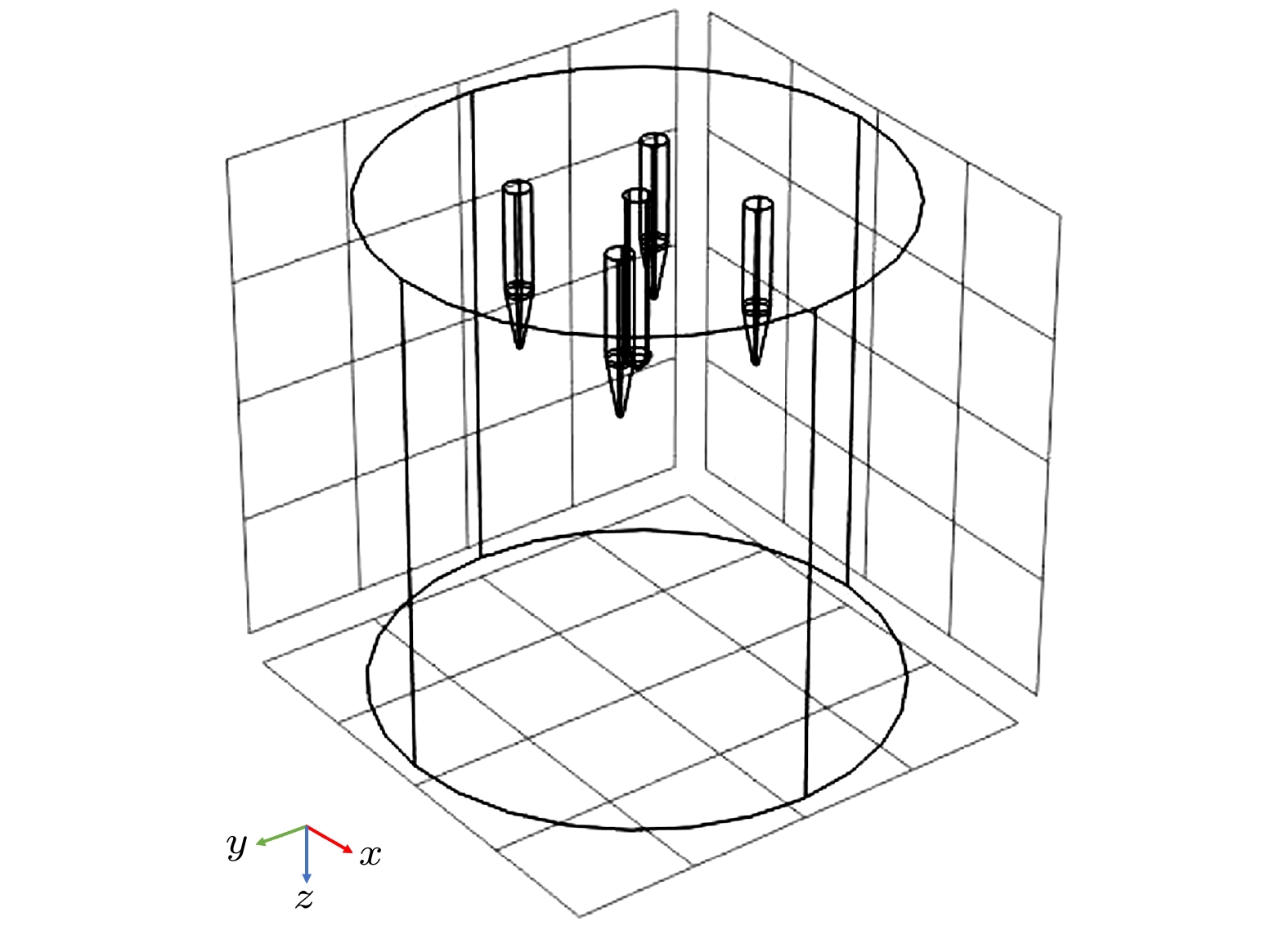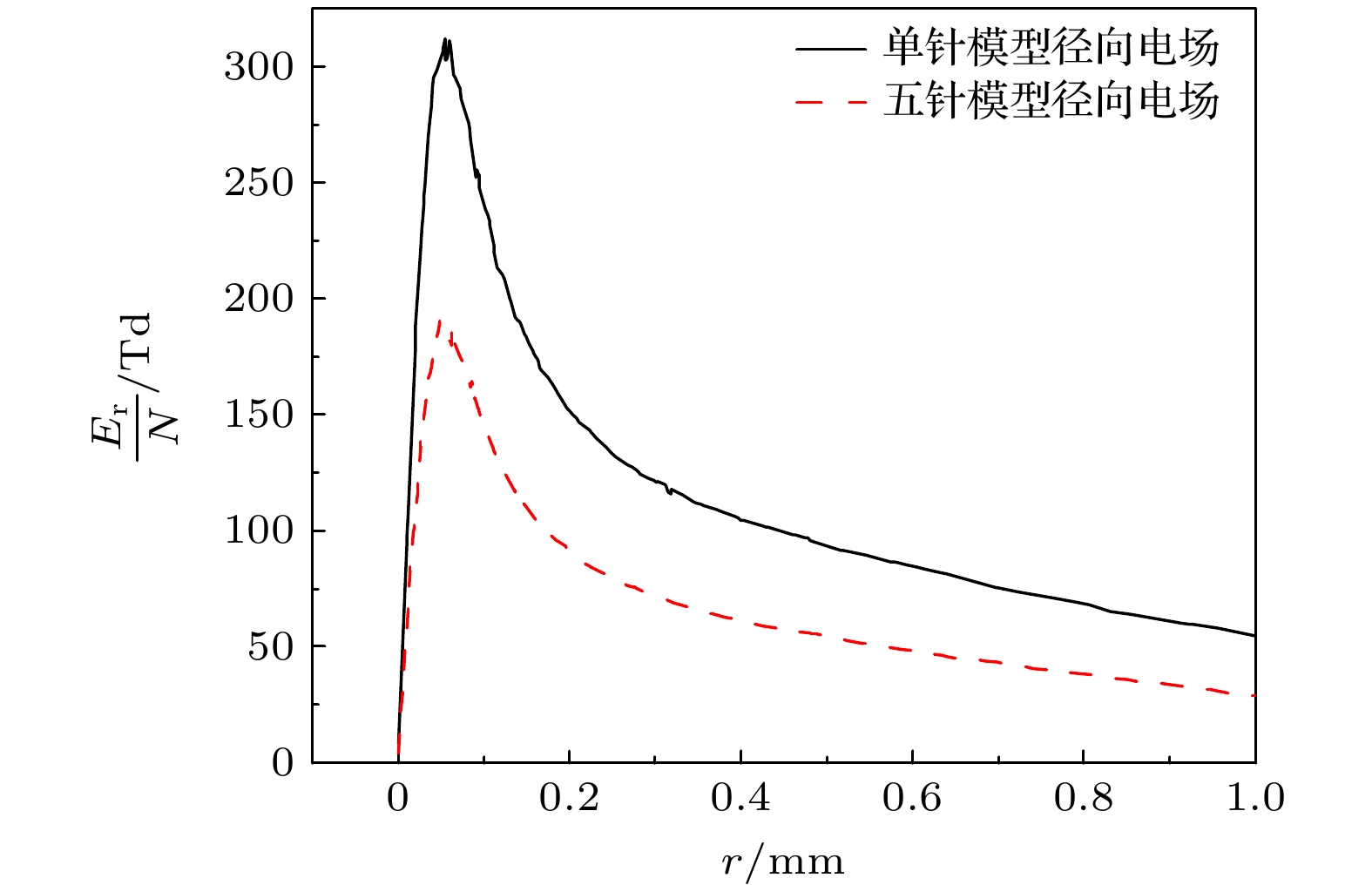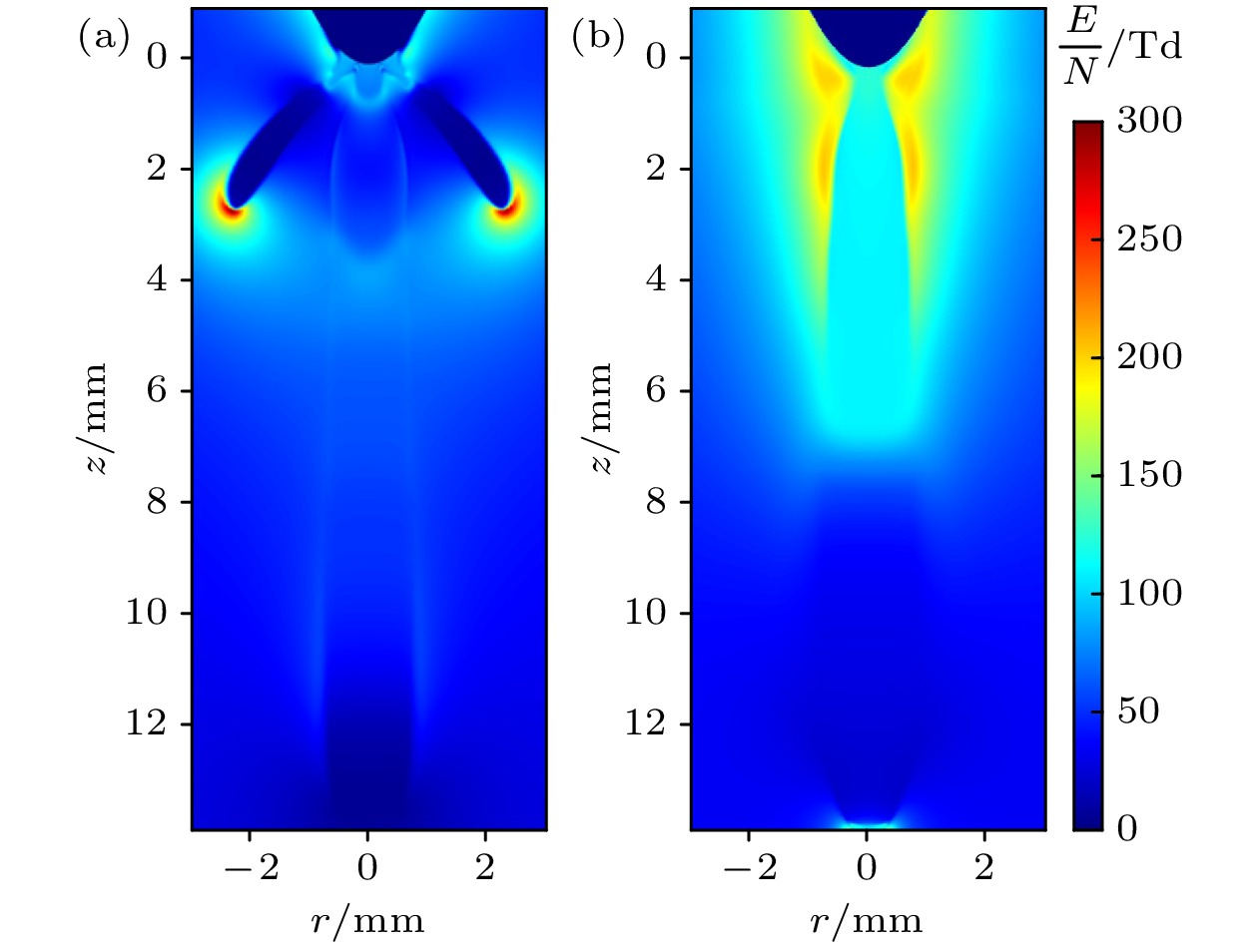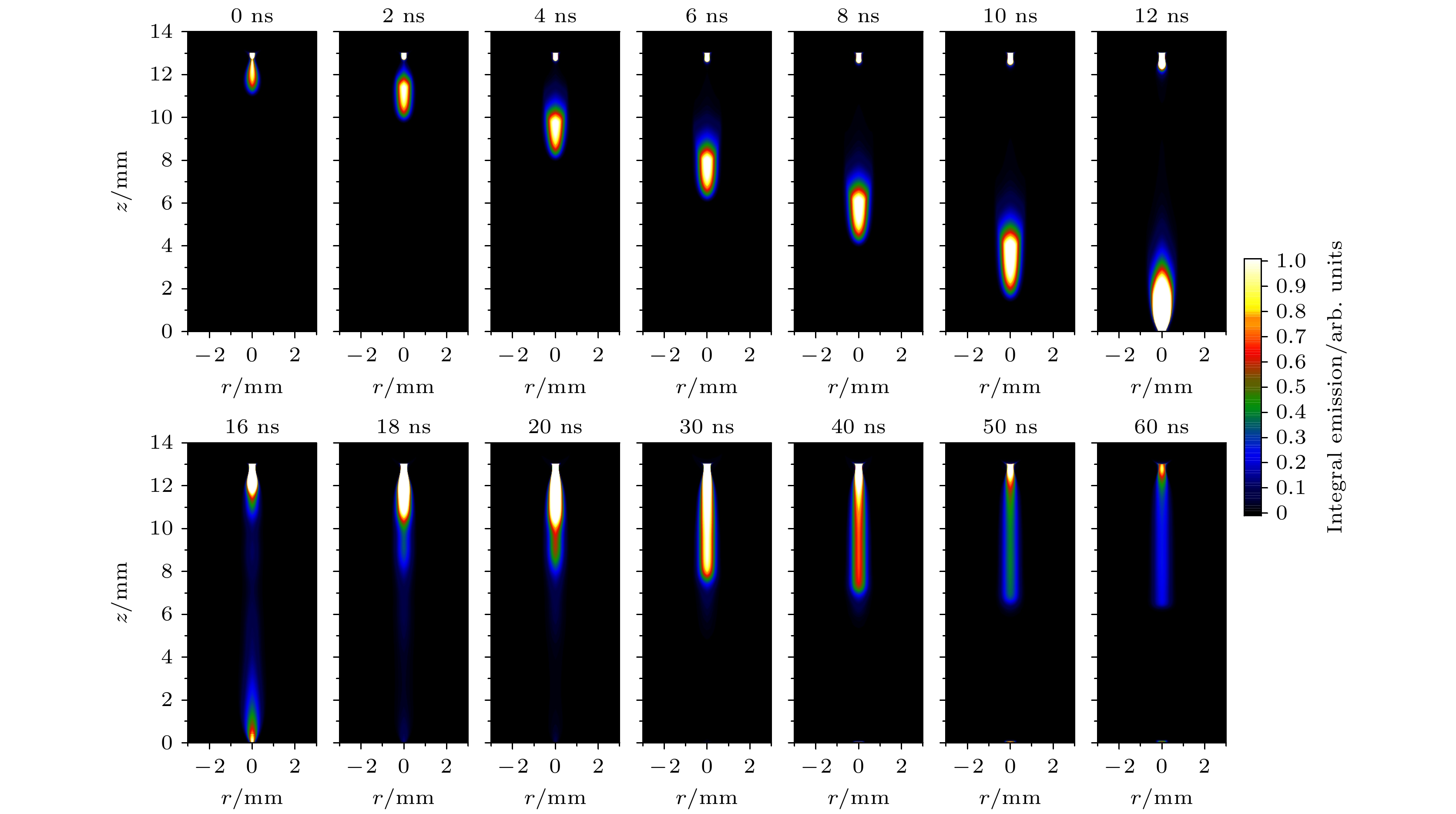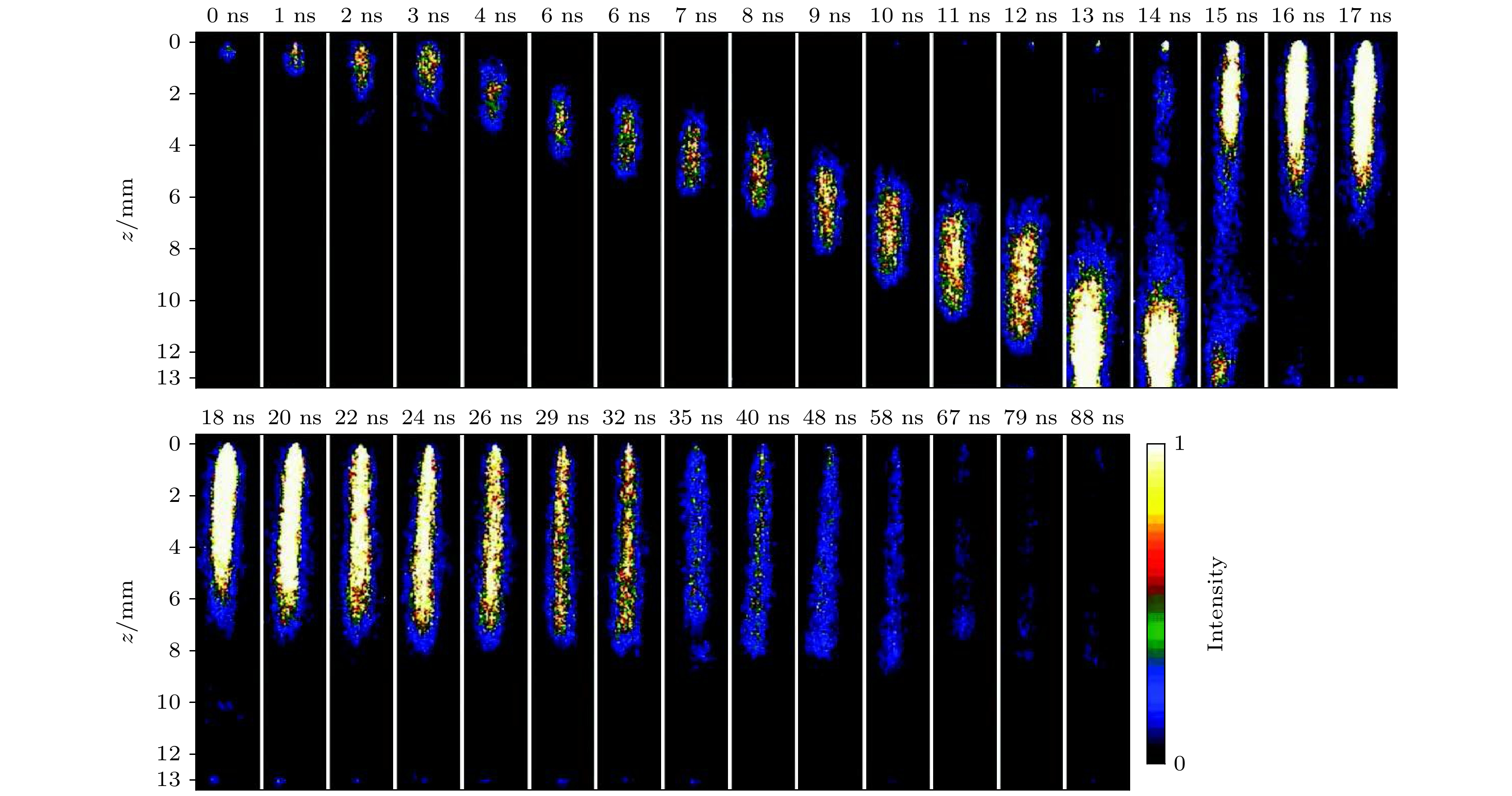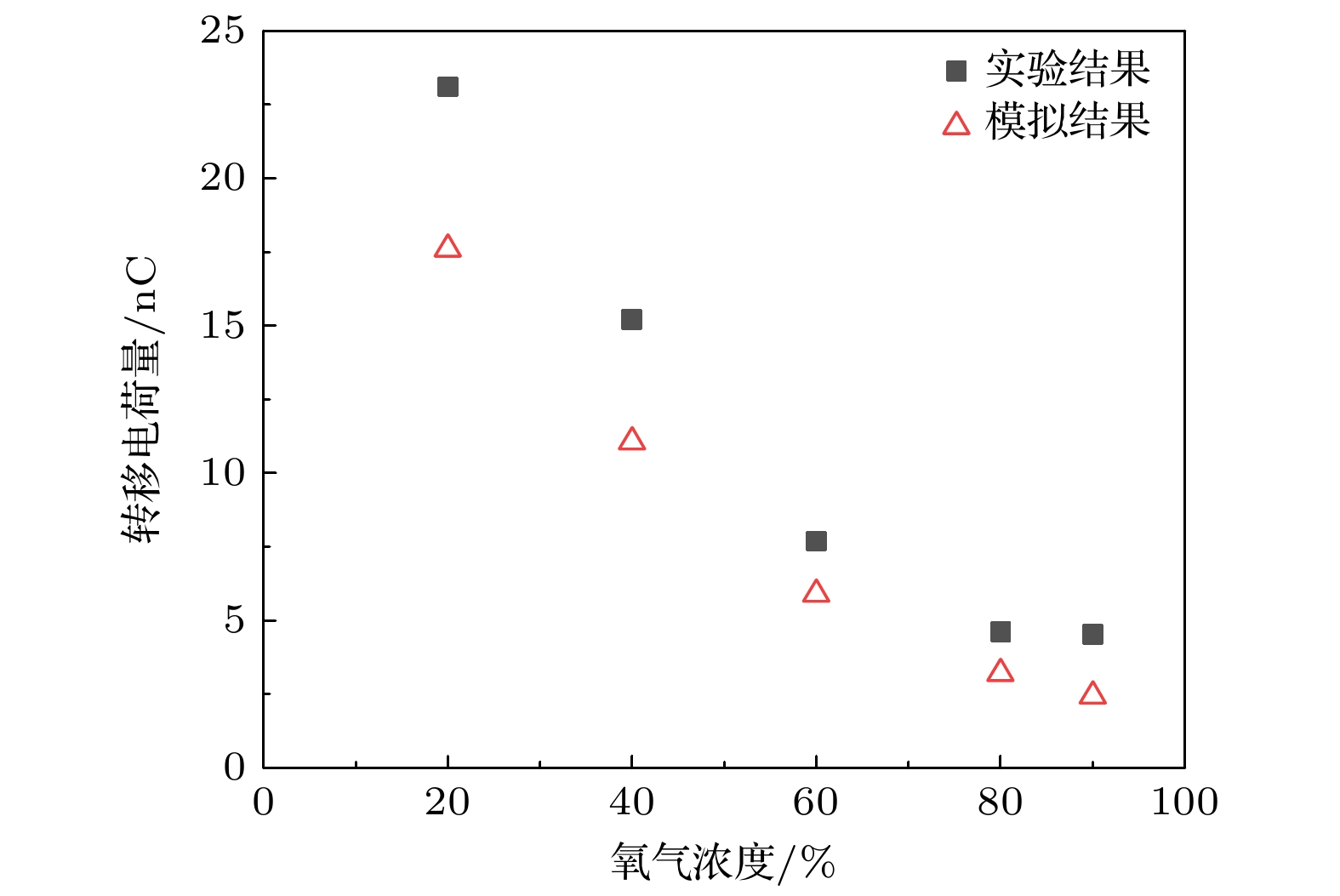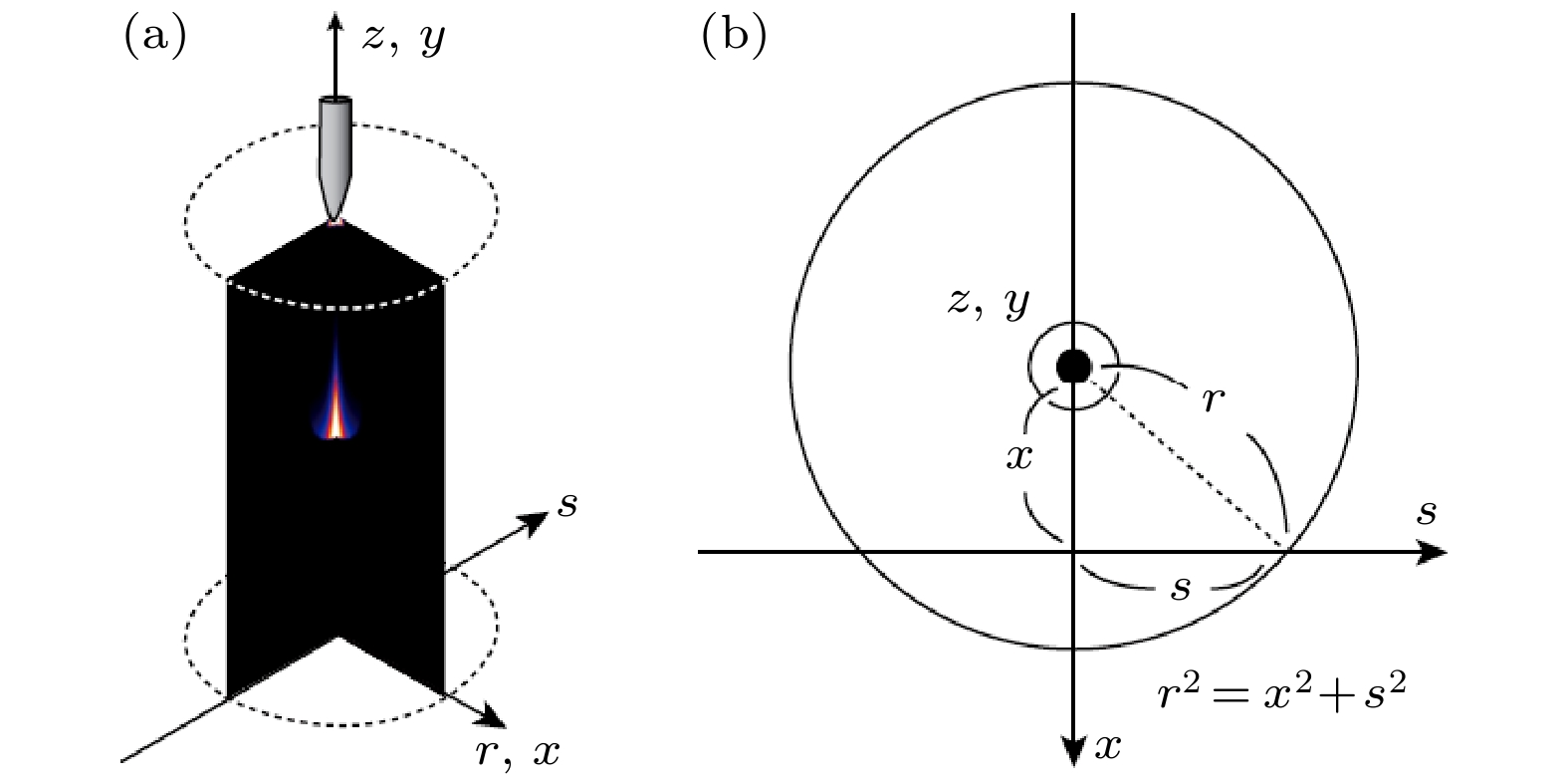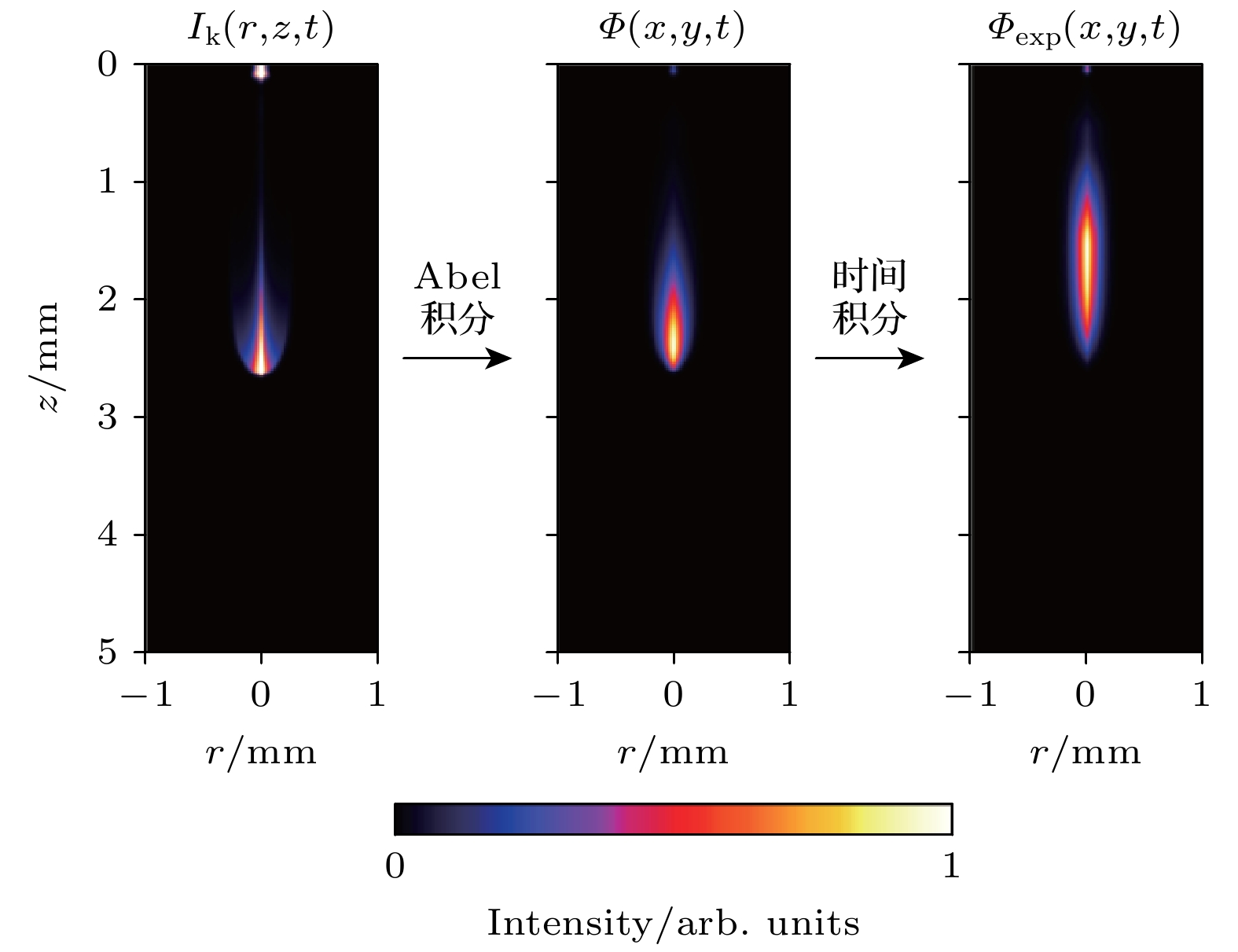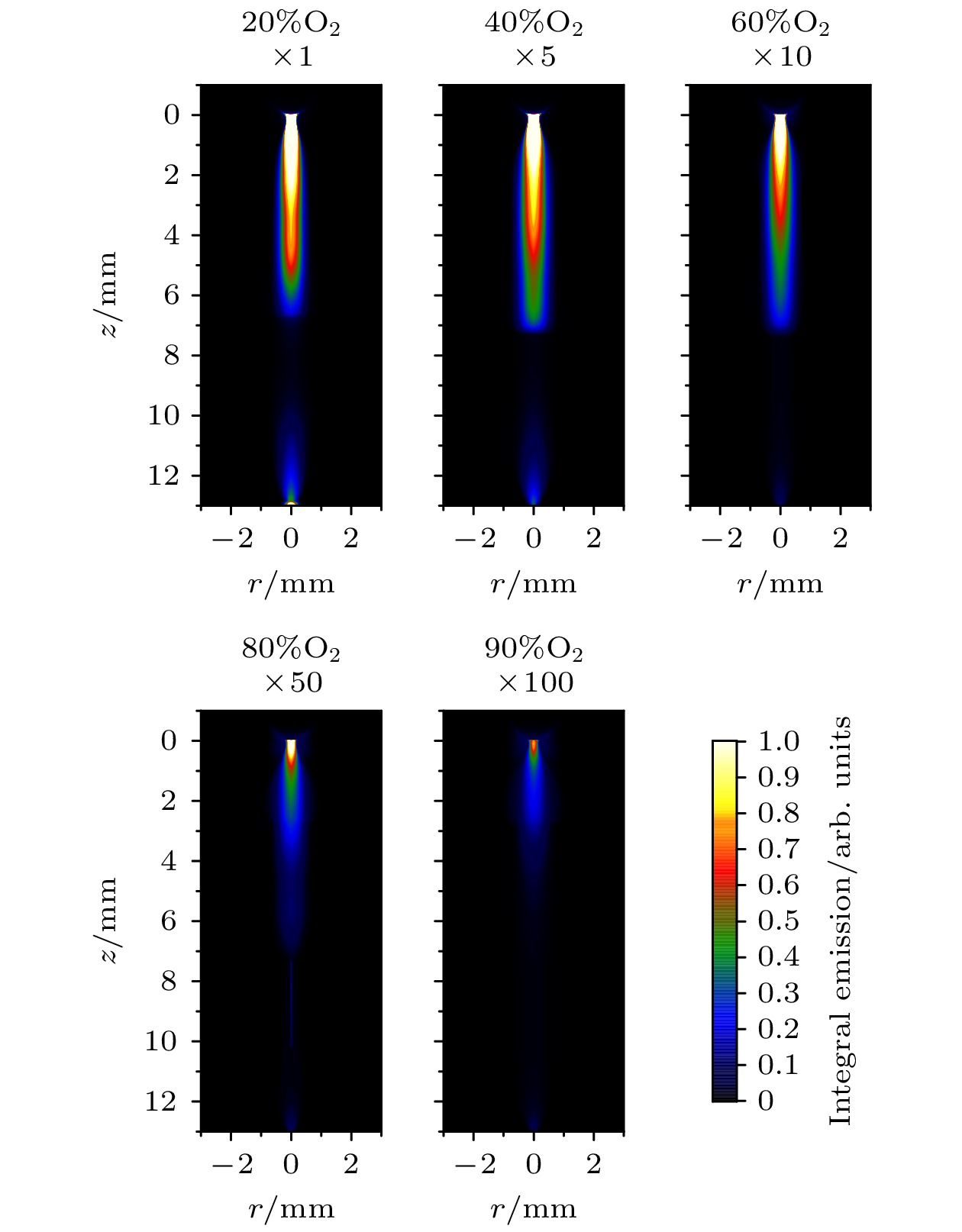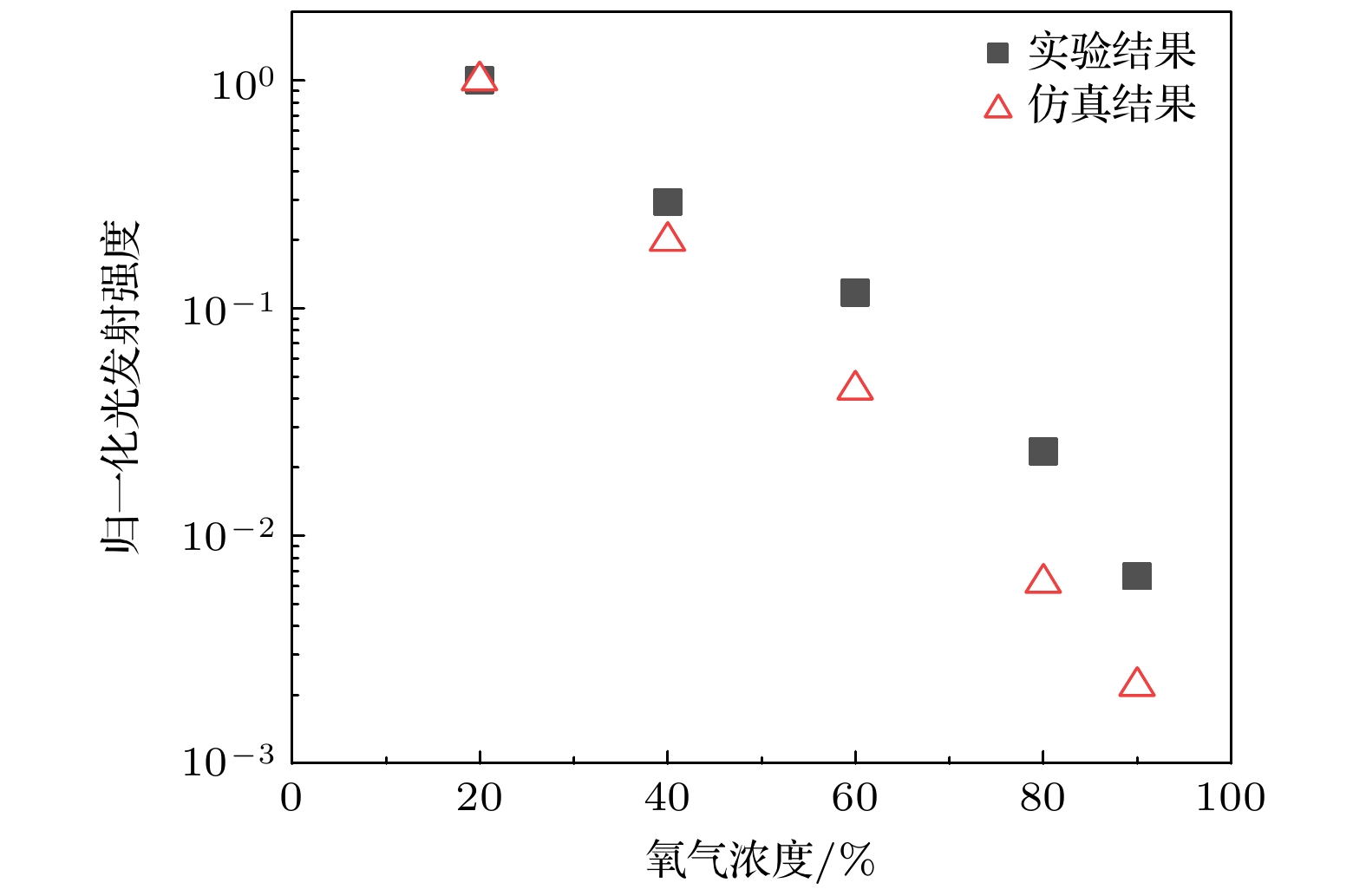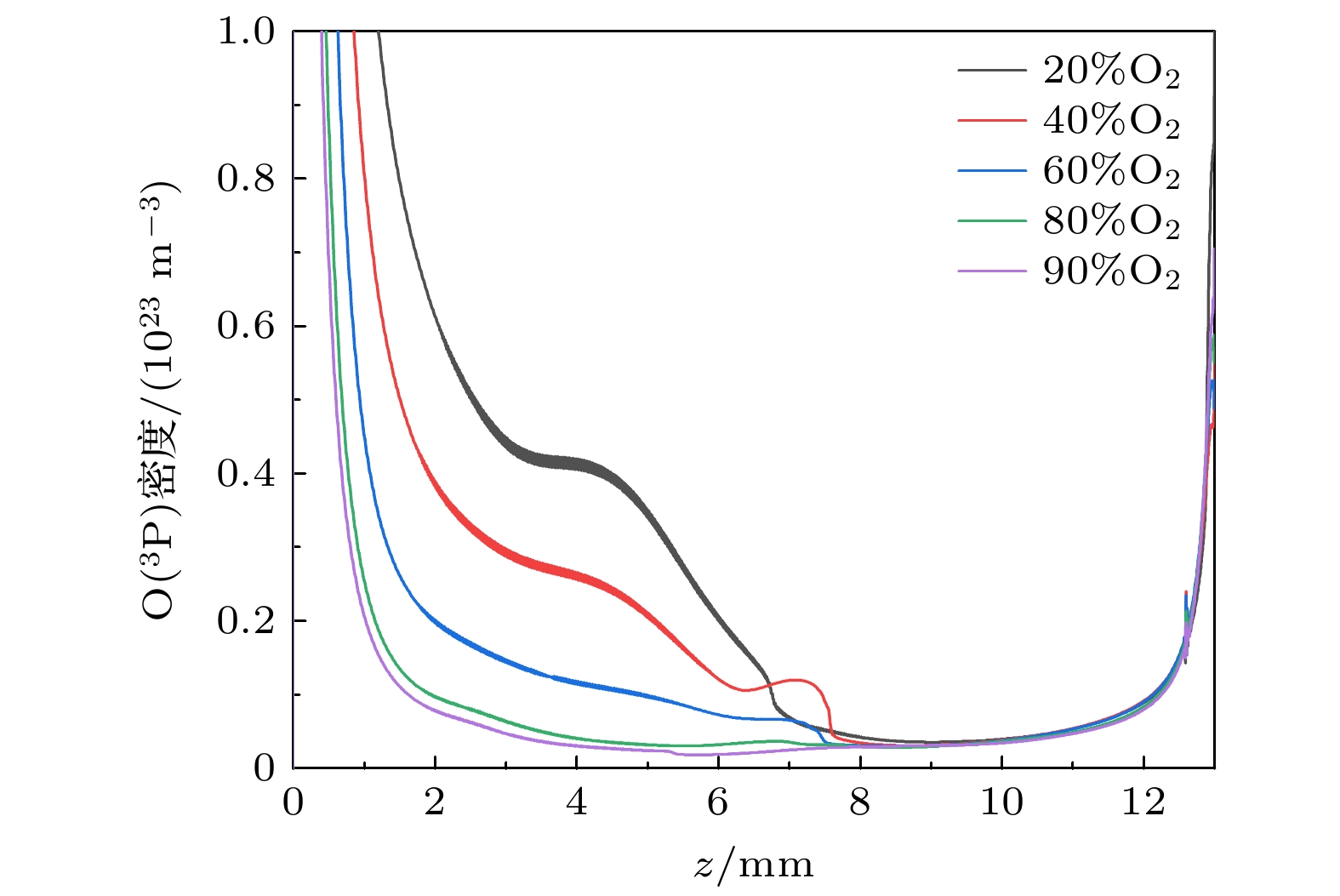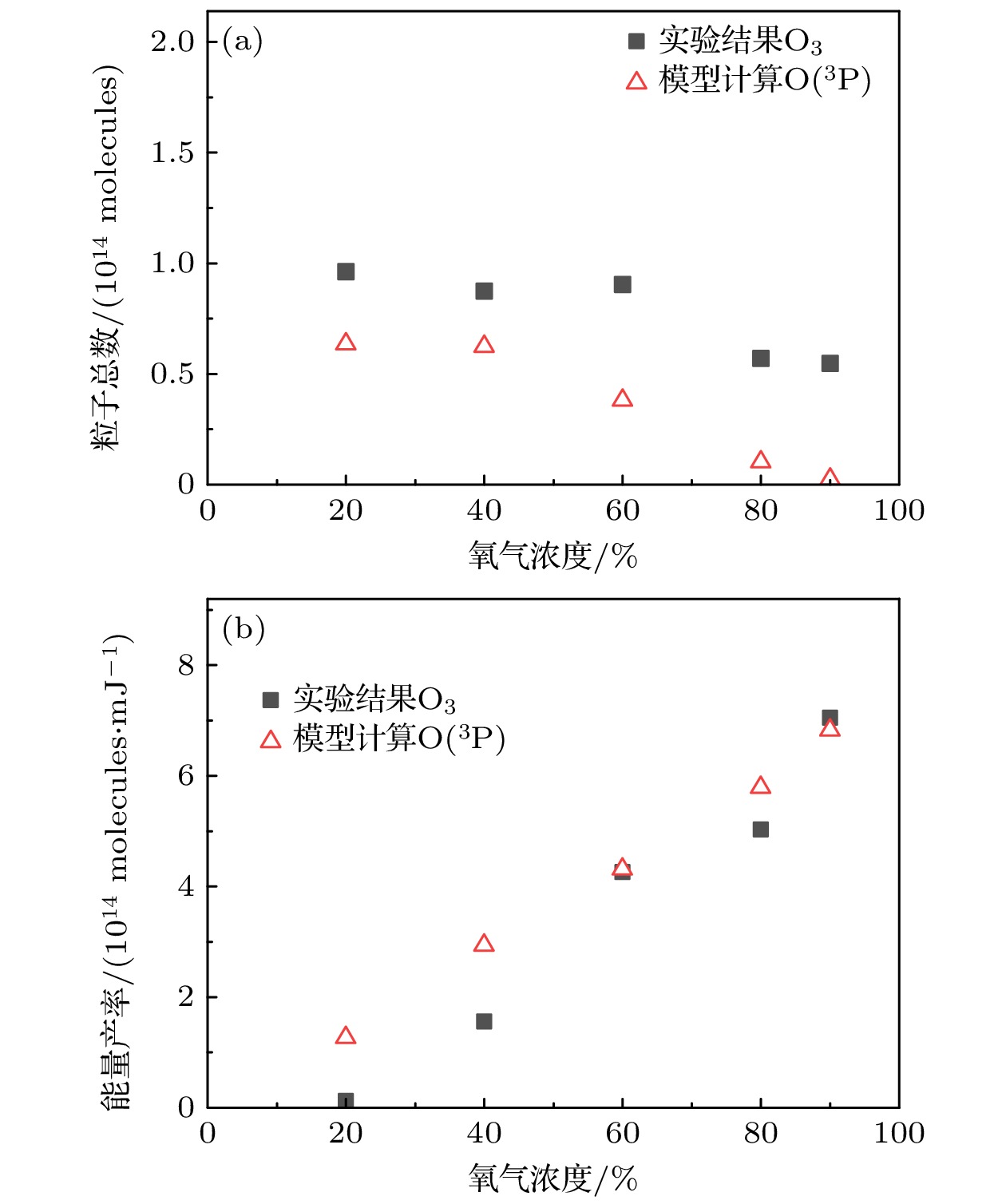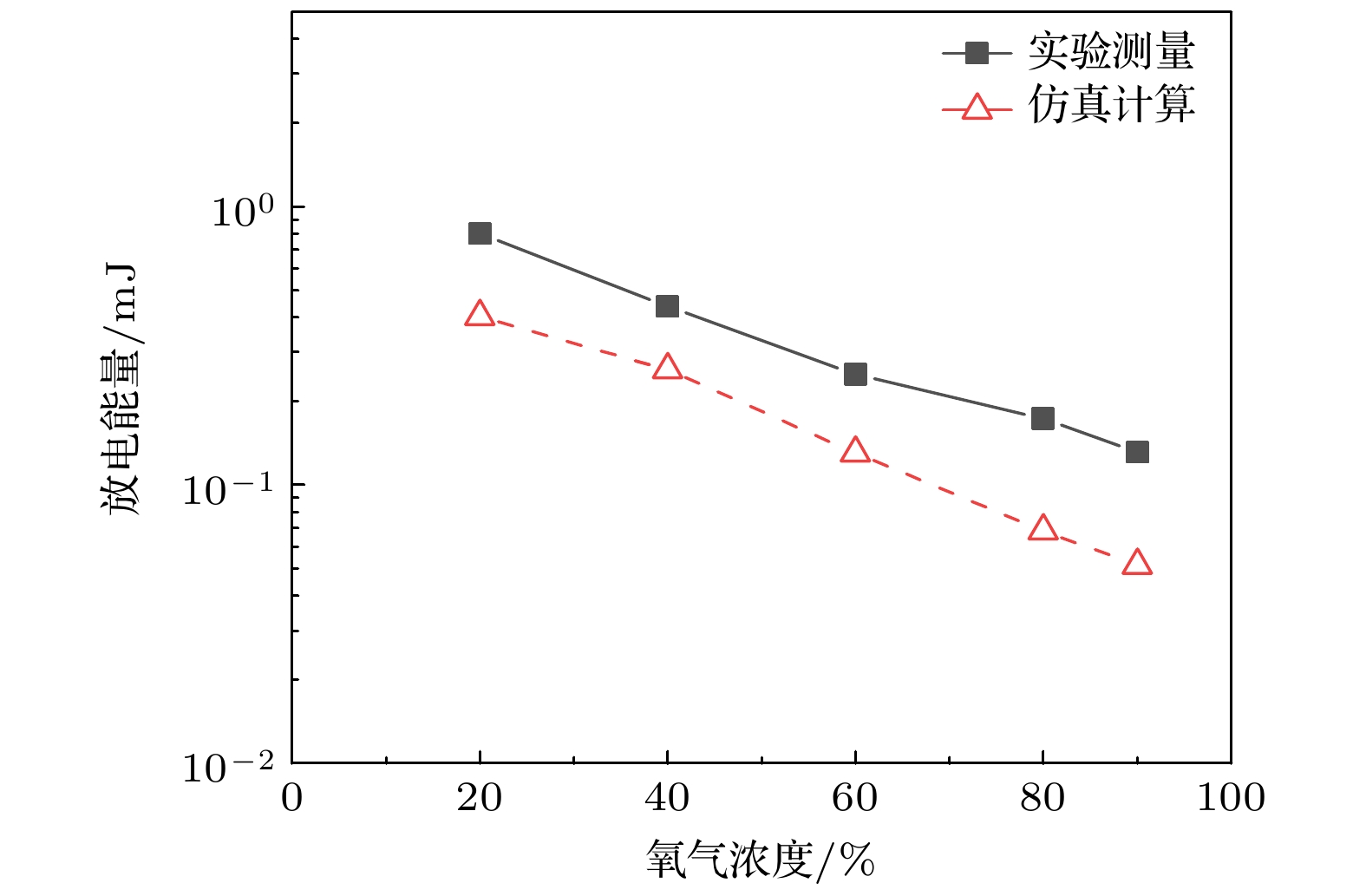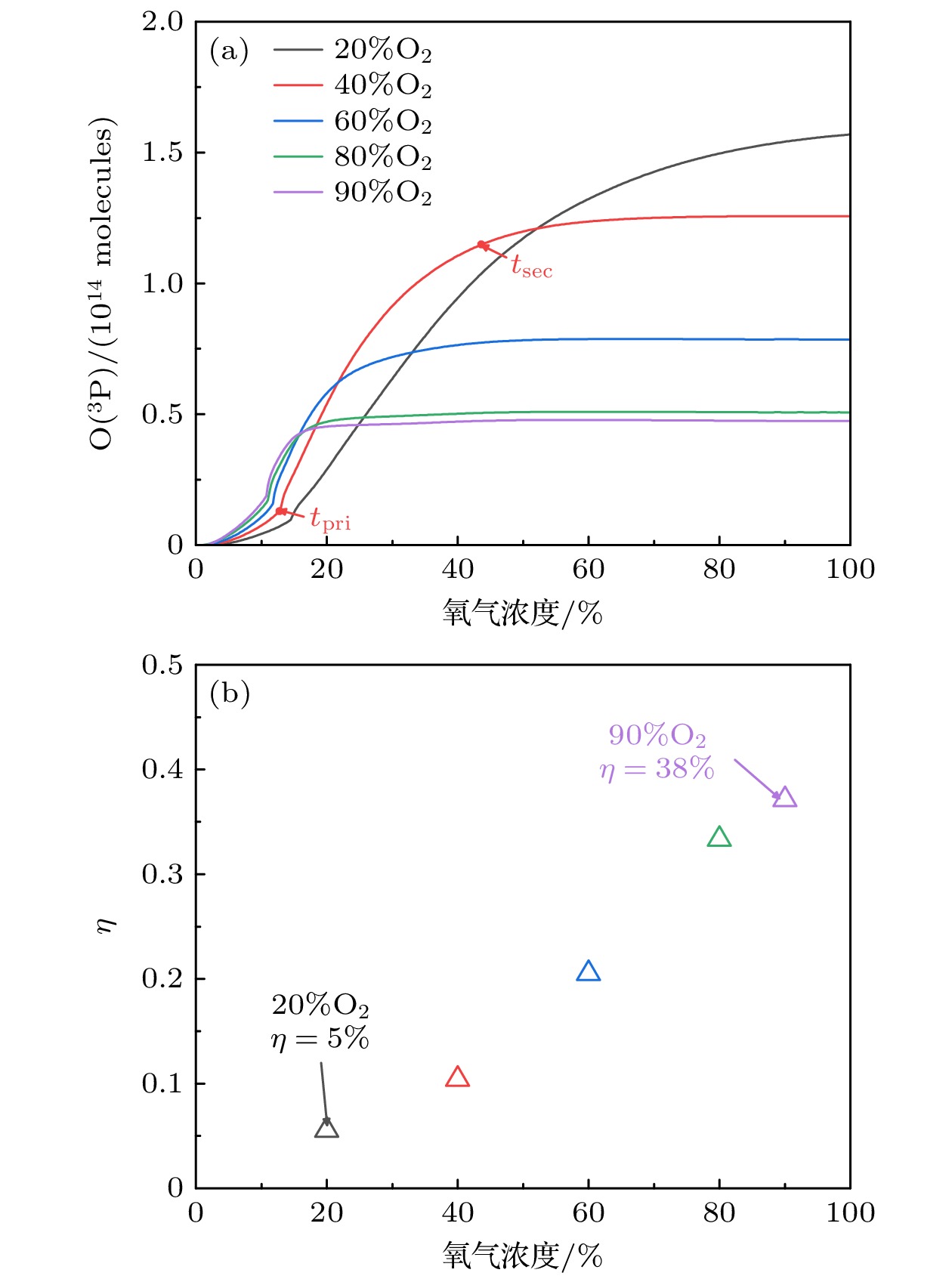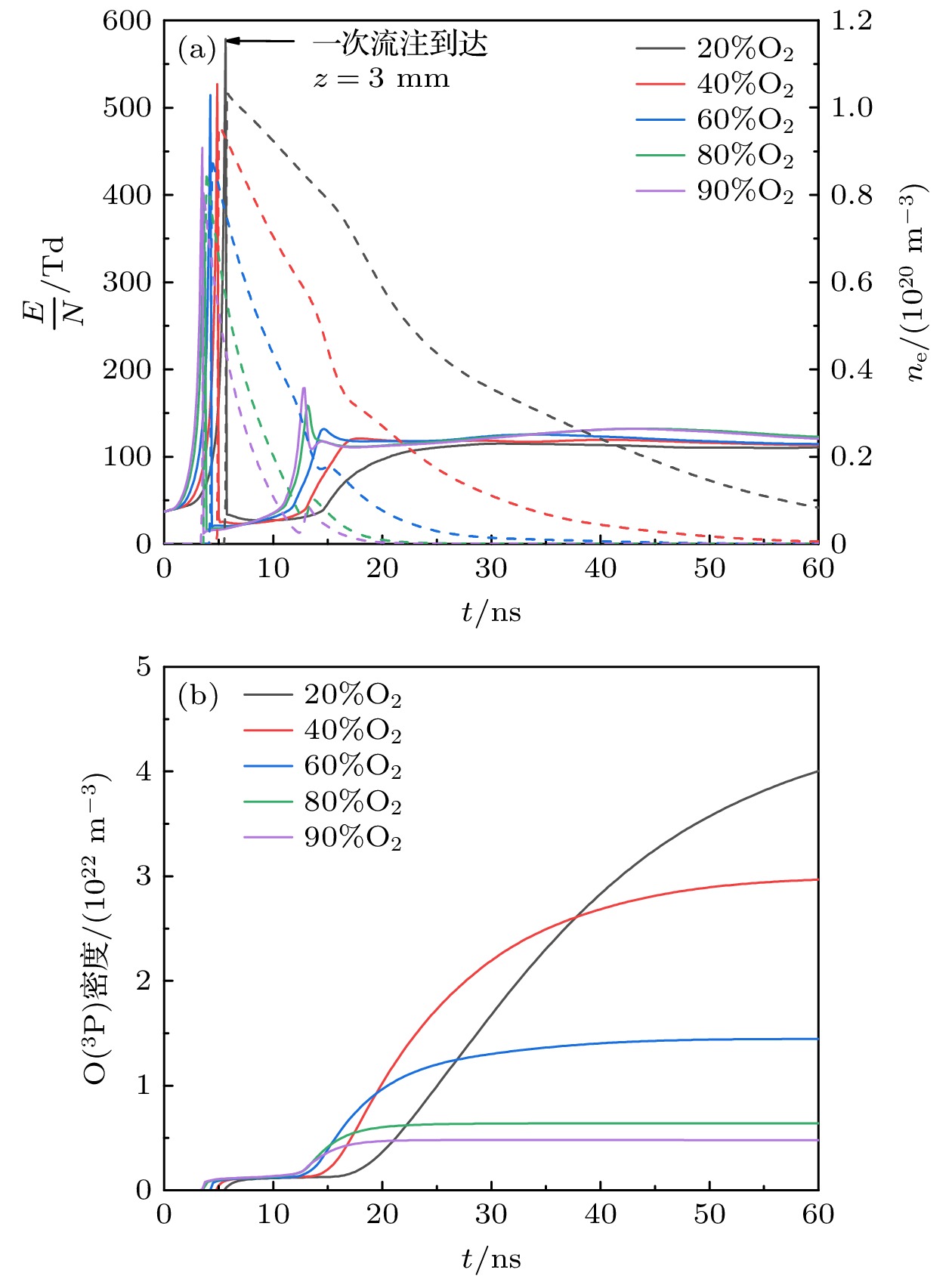-
Streamer discharge has been widely used in fields of sterilization, disinfection, ozone generation, etc. The secondary discharge process significantly affects the effective ozone production duration and efficiency. However, the mechanism of oxygen concentration affecting secondary discharge characteristics and the yield of target products is still unclear. To address this issue, a fluid-based analysis model of the secondary positive streamer discharge process between needle-plate electrodes under varying oxygen concentrations is developed in this work. This model considers the radial electric field and resolves potential non-physical branching issues that may arise in discharge simulations at high oxygen concentrations. In this work, the effect of oxygen concentration on the optical emission characteristics of secondary positive streamers is examined. The optical emission intensity, cathode charge transfer, and the yields of excited-state oxygen atoms (O(3P)) under different oxygen concentrations are investigated and compared with experimental data. The results show that when the oxygen concentration increases from 20% to 90%, the light emission intensity of the secondary discharge decreases by about 0.2%. At the same time, the average electron density in the discharge channel decreases by 90%, the change of electric field intensity is less than 10%, and the duration of single discharge duration is shortened by 77%. Under these conditions, the proportion of O(3P) yield originating from the primary discharge increases from 20% to 38%, and the unit energy yield of excited-state oxygen atoms O(3P) rises by 64%. Although the reduction in discharge duration results in a 50% decrease in absolute O(3P) yield, the increase in unit energy yield far compensates for the decrease in single-discharge yield. The single-discharge yield decreases with oxygen concentration increasing due to the enhanced two- and three-body adsorption effects of oxygen molecules, which reduce the electron density. Additionally, the increased collision probability between electrons and oxygen molecules further affects these characteristic changes.
-
Keywords:
- streamer discharge /
- fluid simulation /
- numerical simulation /
- duration
[1] 李晗蔚, 孙安邦, 张幸, 姚聪伟, 常正实, 张冠军 2018 67 045101
 Google Scholar
Google Scholar
Li H W, Sun A B, Zhang X, Yao C W, Chang Z S, Zhang G J 2018 Acta Phys. Sin 67 045101
 Google Scholar
Google Scholar
[2] Samaranayake W, Miyahara Y, Namihira T, Katsuki S, Sakugawa T, Hackam R, Akiyama H 2000 IEEE Trans. Dielectr. Electr. Insul. 7 254
 Google Scholar
Google Scholar
[3] Fukawa F, Shimomura N, Yano T, Yamanaka S, Teranishi K, Akiyama H 2008 IEEE Trans. Plasma Sci. 36 2592
 Google Scholar
Google Scholar
[4] Komuro A, Yoshino A, Wei Z, Ono R 2023 J. Phys. D: Appl. Phys. 56 185201
 Google Scholar
Google Scholar
[5] Meher P, Deshmukh N, Mashalkar A, Kumar D 2023 AIP Conference Proceedings 2764 1
 Google Scholar
Google Scholar
[6] Wang D, Namihira T 2020 Plasma Sources Sci. Technol. 29 023001
 Google Scholar
Google Scholar
[7] Li X, Sun A, Zhang G, Teunissen J 2020 Plasma Sources Sci. Technol. 29 065004
 Google Scholar
Google Scholar
[8] Syssoev V, Naumova M, Kuznetsov Y, Orlov A, Sukharevsky D, Makalsky L, Kukhno A 2022 Inorg. Mater. Appl. Res. 13 1380
 Google Scholar
Google Scholar
[9] Sisoev V, Zavyalova A, Makalsky L, Kuchno A 2021 IOP Conference Series: Earth and Environmental Science 723 042068
 Google Scholar
Google Scholar
[10] Wei Z, Komuro A, Ono R 2023 Plasma Processes Polym. 21 2300113
 Google Scholar
Google Scholar
[11] Abahazem A, Merbahi N, Ducasse O, Eichwald O, Yousfi M 2008 IEEE Trans. Plasma Sci. 36 924
 Google Scholar
Google Scholar
[12] Ono R, Komuro A 2020 J. Phys. D: Appl. Phys. 53 035202
 Google Scholar
Google Scholar
[13] Ono R, Oda T 2003 J. Phys. D: Appl. Phys. 36 1952
 Google Scholar
Google Scholar
[14] Meek J 1940 Phys. Rev. 57 722
 Google Scholar
Google Scholar
[15] Raether H 1939 Zeitschrift für Physik 112 464
[16] Sigmond R 1984 J. Appl. Phys. 56 1355
 Google Scholar
Google Scholar
[17] Nijdam S, Teunissen J, Takahashi E, Ebert U 2016 Plasma Sources Sci. Technol. 25 044001
 Google Scholar
Google Scholar
[18] Eichwald O, Ducasse O, Dubois D, Abahazem A, Merbahi N, Benhenni M, Yousfi M 2008 J. Phys. D: Appl. Phys. 41 234002
 Google Scholar
Google Scholar
[19] Babaeva N Y, Naidis G 1996 J. Phys. D: Appl. Phys. 29 2423
 Google Scholar
Google Scholar
[20] Zhelezniak M, Mnatsakanian A K, Sizykh S V 1982 High Temperature Science 20 357
[21] Ono R, Takezawa K, Oda T 2009 J. Appl. Phys. 106 043302
 Google Scholar
Google Scholar
[22] Komuro A, Ono R, Oda T 2013 J. Phys. D: Appl. Phys. 46 175206
 Google Scholar
Google Scholar
[23] Komuro A, Takahashi K, Ando A 2015 J. Phys. D: Appl. Phys. 48 215203
 Google Scholar
Google Scholar
[24] Wei Z, Komuro A, Ono R 2023 Plasma Sources Sci. Technol. 32 115016
 Google Scholar
Google Scholar
[25] Phelps and Morgan Databases, Murphy T I https://us.lxcat.net/contributors/ [2024-11-04]
[26] Hagelaar G, Pitchford L C 2005 Plasma Sources Sci. Technol. 14 722
 Google Scholar
Google Scholar
[27] Bourdon A, Pasko V, Liu N Y, Célestin S, Ségur P, Marode E 2007 Plasma Sources Sci. Technol. 16 656
 Google Scholar
Google Scholar
[28] Yoshida K, Komuro A, Wada N, Naito T, Ando A 2022 J. Electrostat. 117 103716
 Google Scholar
Google Scholar
[29] DeMore W, Sander S, Golden D, Hampson R, Kurylo M, Howard C, Ravishankara A, Kolb C, Molina M 1997 JPL Publication 97 1
[30] Komuro A, Ono R, Oda T 2013 Plasma Sources Sci. Technol. 22 045002
 Google Scholar
Google Scholar
[31] Komuro A, Takahashi K, Ando A 2017 Plasma Sources Sci. Technol. 26 065003
 Google Scholar
Google Scholar
-
图 16 (a) 不同氧浓度下产生的$ \rm O(^3 P) $总量随时间变化; (b) 不同氧浓度下一次流注产生的$ \rm O(^3 P) $产量与总产量比值
Figure 16. The dependence of the total amount of $ \rm O(^3 P) $ produced on the time at various oxygen concentrations; (b) fraction of $ \rm O(^3 P) $ produced by the primary streamer to the total amount of $ \rm O(^3 P) $ production at various oxygen concentrations.
图 17 (a) 不同氧浓度下, E/N (实线)和电子密度(虚线)随时间的变化; (b)不同氧浓度下, 对称轴上z = 3 mm处的$ \rm O(^3 P) $密度随时间的变化
Figure 17. (a) Time dependencies of E/N (solid line) and the electron density (dashed line) under various O2 concentrations; (b) time dependencies of $ \rm O(^3 P) $ density at z = 3 mm on the symmetric axis under various O2 concentrations.
-
[1] 李晗蔚, 孙安邦, 张幸, 姚聪伟, 常正实, 张冠军 2018 67 045101
 Google Scholar
Google Scholar
Li H W, Sun A B, Zhang X, Yao C W, Chang Z S, Zhang G J 2018 Acta Phys. Sin 67 045101
 Google Scholar
Google Scholar
[2] Samaranayake W, Miyahara Y, Namihira T, Katsuki S, Sakugawa T, Hackam R, Akiyama H 2000 IEEE Trans. Dielectr. Electr. Insul. 7 254
 Google Scholar
Google Scholar
[3] Fukawa F, Shimomura N, Yano T, Yamanaka S, Teranishi K, Akiyama H 2008 IEEE Trans. Plasma Sci. 36 2592
 Google Scholar
Google Scholar
[4] Komuro A, Yoshino A, Wei Z, Ono R 2023 J. Phys. D: Appl. Phys. 56 185201
 Google Scholar
Google Scholar
[5] Meher P, Deshmukh N, Mashalkar A, Kumar D 2023 AIP Conference Proceedings 2764 1
 Google Scholar
Google Scholar
[6] Wang D, Namihira T 2020 Plasma Sources Sci. Technol. 29 023001
 Google Scholar
Google Scholar
[7] Li X, Sun A, Zhang G, Teunissen J 2020 Plasma Sources Sci. Technol. 29 065004
 Google Scholar
Google Scholar
[8] Syssoev V, Naumova M, Kuznetsov Y, Orlov A, Sukharevsky D, Makalsky L, Kukhno A 2022 Inorg. Mater. Appl. Res. 13 1380
 Google Scholar
Google Scholar
[9] Sisoev V, Zavyalova A, Makalsky L, Kuchno A 2021 IOP Conference Series: Earth and Environmental Science 723 042068
 Google Scholar
Google Scholar
[10] Wei Z, Komuro A, Ono R 2023 Plasma Processes Polym. 21 2300113
 Google Scholar
Google Scholar
[11] Abahazem A, Merbahi N, Ducasse O, Eichwald O, Yousfi M 2008 IEEE Trans. Plasma Sci. 36 924
 Google Scholar
Google Scholar
[12] Ono R, Komuro A 2020 J. Phys. D: Appl. Phys. 53 035202
 Google Scholar
Google Scholar
[13] Ono R, Oda T 2003 J. Phys. D: Appl. Phys. 36 1952
 Google Scholar
Google Scholar
[14] Meek J 1940 Phys. Rev. 57 722
 Google Scholar
Google Scholar
[15] Raether H 1939 Zeitschrift für Physik 112 464
[16] Sigmond R 1984 J. Appl. Phys. 56 1355
 Google Scholar
Google Scholar
[17] Nijdam S, Teunissen J, Takahashi E, Ebert U 2016 Plasma Sources Sci. Technol. 25 044001
 Google Scholar
Google Scholar
[18] Eichwald O, Ducasse O, Dubois D, Abahazem A, Merbahi N, Benhenni M, Yousfi M 2008 J. Phys. D: Appl. Phys. 41 234002
 Google Scholar
Google Scholar
[19] Babaeva N Y, Naidis G 1996 J. Phys. D: Appl. Phys. 29 2423
 Google Scholar
Google Scholar
[20] Zhelezniak M, Mnatsakanian A K, Sizykh S V 1982 High Temperature Science 20 357
[21] Ono R, Takezawa K, Oda T 2009 J. Appl. Phys. 106 043302
 Google Scholar
Google Scholar
[22] Komuro A, Ono R, Oda T 2013 J. Phys. D: Appl. Phys. 46 175206
 Google Scholar
Google Scholar
[23] Komuro A, Takahashi K, Ando A 2015 J. Phys. D: Appl. Phys. 48 215203
 Google Scholar
Google Scholar
[24] Wei Z, Komuro A, Ono R 2023 Plasma Sources Sci. Technol. 32 115016
 Google Scholar
Google Scholar
[25] Phelps and Morgan Databases, Murphy T I https://us.lxcat.net/contributors/ [2024-11-04]
[26] Hagelaar G, Pitchford L C 2005 Plasma Sources Sci. Technol. 14 722
 Google Scholar
Google Scholar
[27] Bourdon A, Pasko V, Liu N Y, Célestin S, Ségur P, Marode E 2007 Plasma Sources Sci. Technol. 16 656
 Google Scholar
Google Scholar
[28] Yoshida K, Komuro A, Wada N, Naito T, Ando A 2022 J. Electrostat. 117 103716
 Google Scholar
Google Scholar
[29] DeMore W, Sander S, Golden D, Hampson R, Kurylo M, Howard C, Ravishankara A, Kolb C, Molina M 1997 JPL Publication 97 1
[30] Komuro A, Ono R, Oda T 2013 Plasma Sources Sci. Technol. 22 045002
 Google Scholar
Google Scholar
[31] Komuro A, Takahashi K, Ando A 2017 Plasma Sources Sci. Technol. 26 065003
 Google Scholar
Google Scholar
Catalog
Metrics
- Abstract views: 543
- PDF Downloads: 11
- Cited By: 0














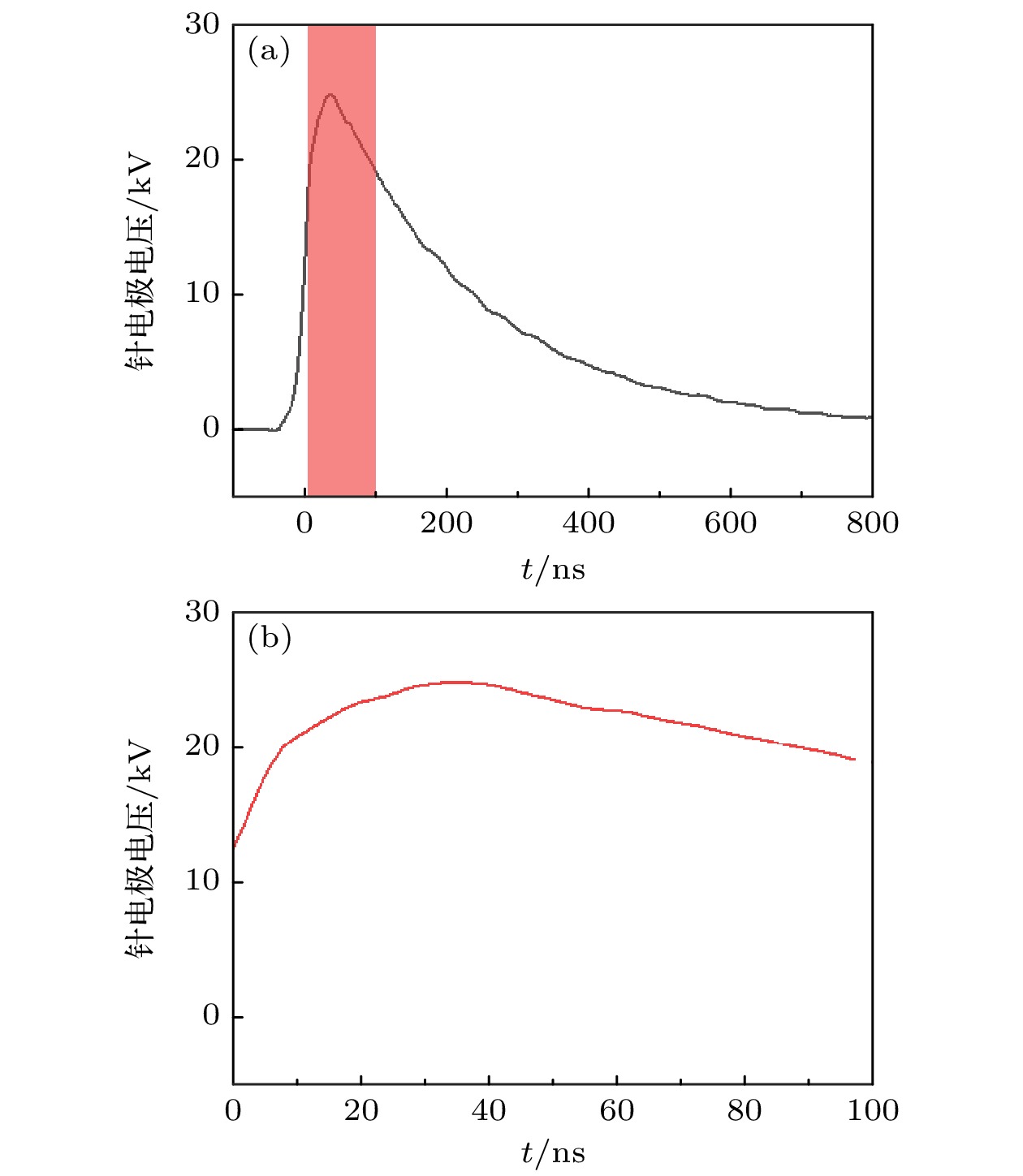
 DownLoad:
DownLoad:
